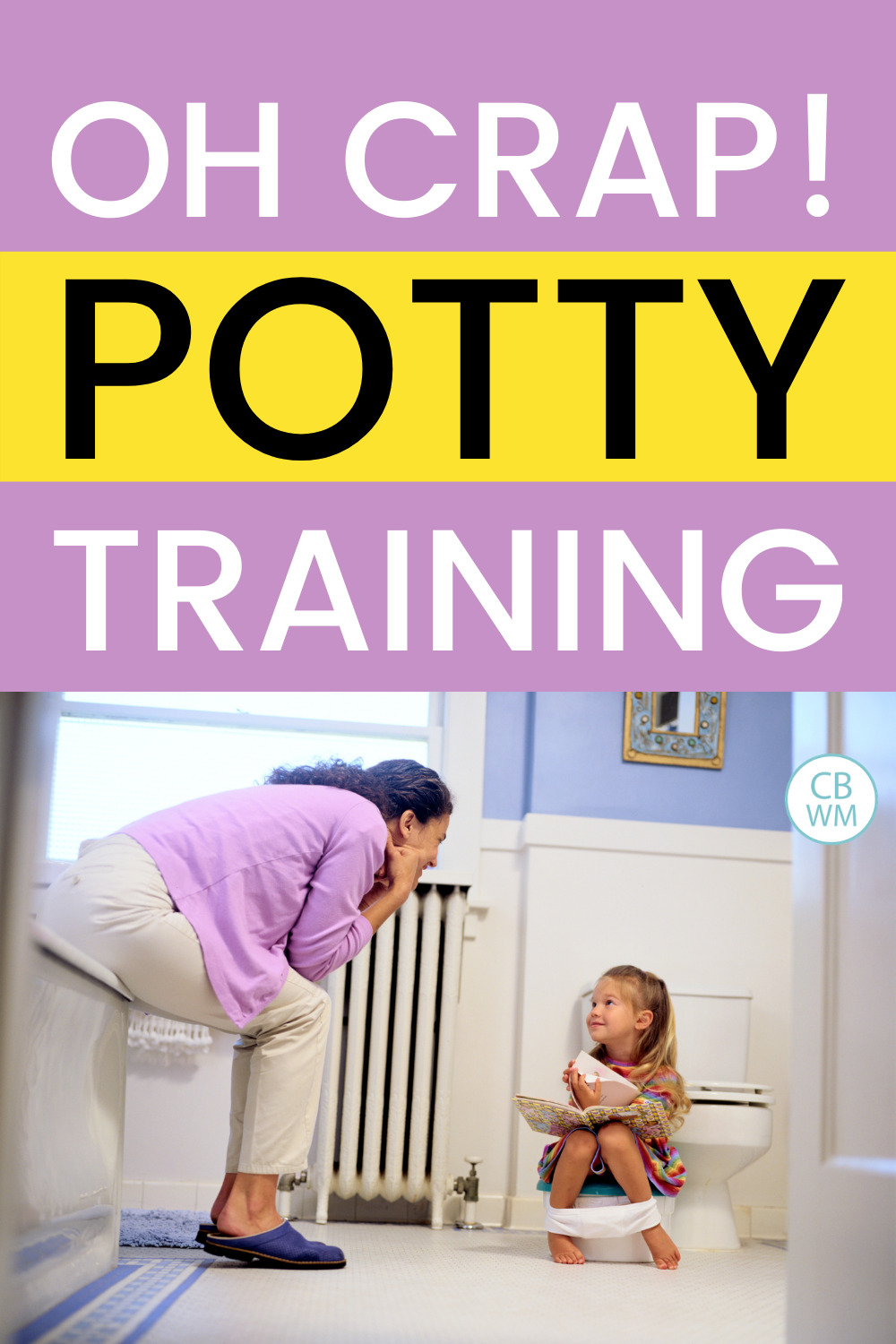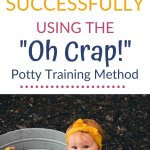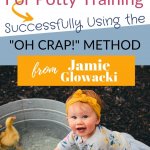How to successfully potty train your little one using the “Oh Crap!” Potty Training Method from Jamie Glowacki. Get step-by-step tips for success on your potty training journey.
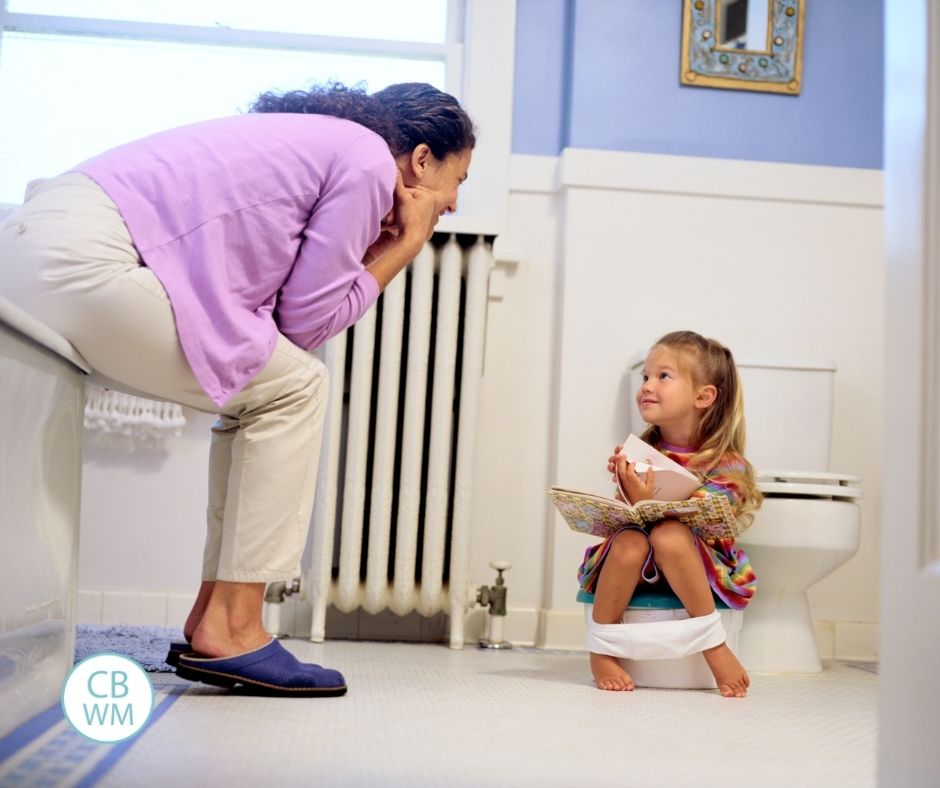
by Autumn Battaglia
If you are wondering if it’s time to potty-train your child, the answer is probably YES!
Confession: I’m not a potty-training expert. I’ve only potty-trained one child so far and made mistakes along the way. I have no formal training. However, I tried one method in our first attempt and it worked! This post is an overview of MY experience with the “Oh Crap! Potty Training” (OCPT) method.
Jamie Glowacki is the author of the book “Oh Crap! Potty Training: Everything Modern Parents Need to Know to Do It Once and Do It Right”. She has over a decade of experience in professional potty-training and has personally worked with thousands of families to potty train their kids. She has a blog, podcast, YouTube channel, and more, so she KNOWS what she’s talking about.
After training my oldest in just a couple days using the OCPT method, I can’t stop recommending it to everyone. It’s very straight-forward. You just follow the steps in the block formula, not moving on to the next block until the previous one is mastered. Jamie is funny, sarcastic, open, and honest in her writing.
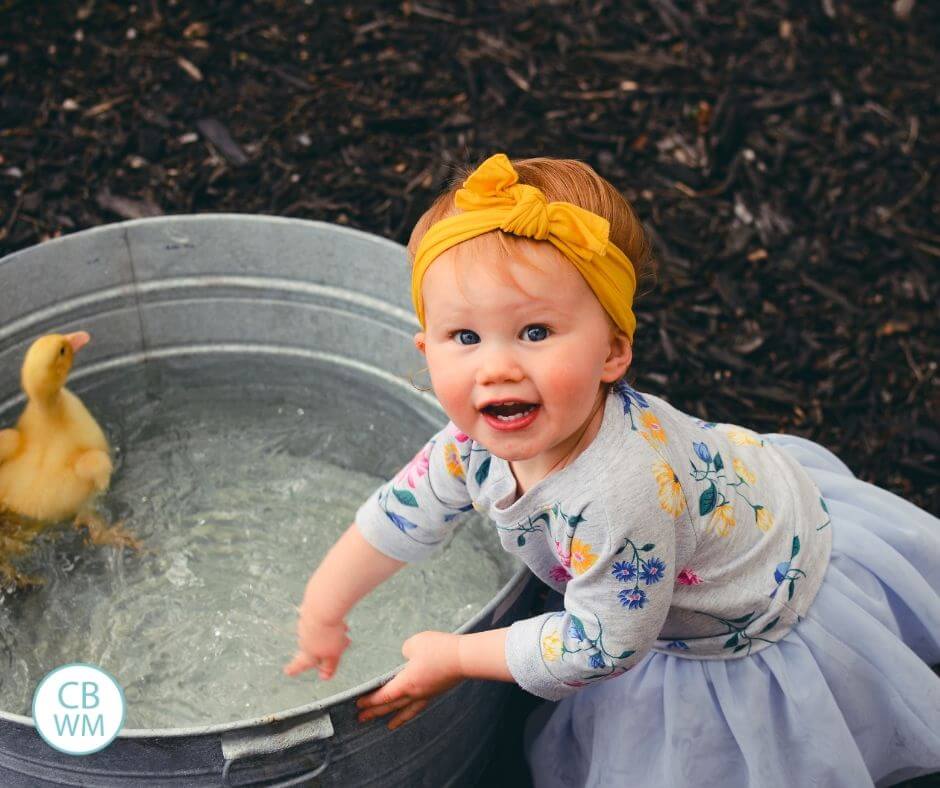
Post Contents
- So where do I begin?
- When do I start?/Is my child “ready”?
- Outline of the Potty Training Process
- Block One: Peeping and pooping while naked, either with prompting or without.
- Block Two: Peeing and pooping with clothes on, commando, with prompting or without.
- Block Three: Peeing and pooping in different situations, with prompting or without.
- Block Four: Peeing and pooping with underpants, with prompting or without.
- Block Five: Consistent self-initiation.
- Block Six: Night and nap (unless you are choosing to do it all together).
- Block Seven: College. Probably still needing to prompt occasionally.
- Conclusion
- Related Posts
So where do I begin?
First, read the book. I read the whole thing before we started and then held onto it for reference throughout. It goes into each block in great detail, gives examples of what it will look like, and helps troubleshoot common problems in that block. I’m going to briefly describe the blocks and what they looked like for us, but every child is different and I can only speak for the one child I’ve used this method on personally. One important fact that she points out many times in the book is that you’re the expert on our own child. The OCPT method should work for almost any child, but your approach to the blocks is going to look different when considering YOUR child and yourself.

When do I start?/Is my child “ready”?
Jamie highly recommends starting this process between 20 and 30 months old. Kids can be trained outside of this window, but it’s usually harder. My son was 28 months old. She looks for some readiness signs like your child going somewhere for “privacy” when they’re going to poop, being able to recite their ABCs, and having a vague ability to communicate their needs (able to ask for a drink or food, etc.)
Before reading the book, I told people that I didn’t think our son was “ready” because he showed NO interest, NO initiation, NO signs that he needed to or had peed/pooped in his diaper. In hindsight, he was probably ready a lot sooner than we were able to recognize. And frankly, I was intimidated by the process and unsure of where to start. But let’s just jump into the blocks and our experience with them.
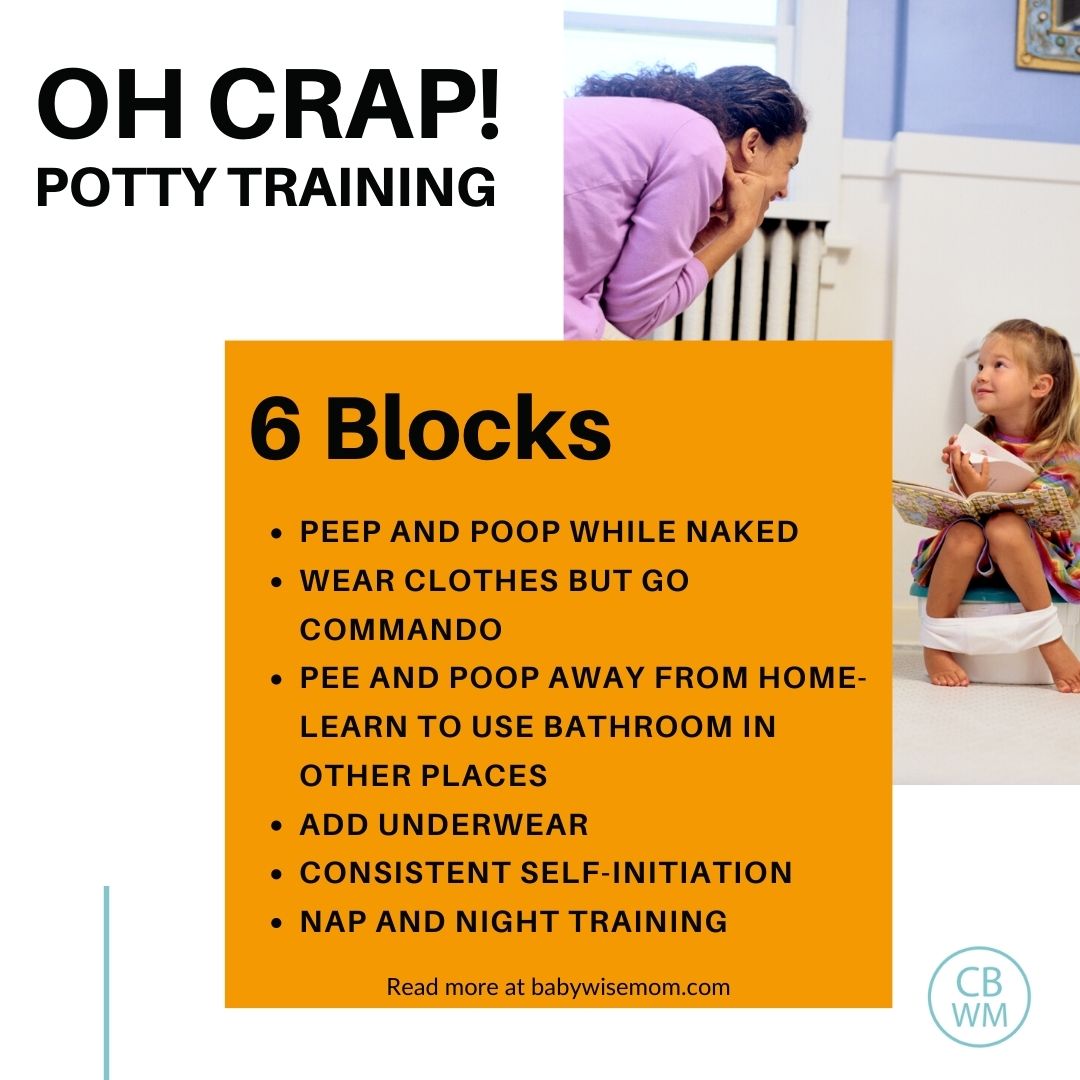
Outline of the Potty Training Process
Oh Crap! Potty Training: Everything Modern Parents Need to Know to Do It Once and Do It Right is set up into blocks. Let’s discuss the Oh Crap Potty Training Blocks, or Oh Crap Potty Training steps.
Block One: Peeping and pooping while naked, either with prompting or without.
For us, the first block was about four days. Basically, you take the diaper off your child and plan to spend a few days at home with your kid totally naked (or at least from the waist down).
That means no diaper, no pull-ups, no undies, and no pants.
You just literally watch them like a hawk all day to catch them starting to pee/poop. You will NEED to have a small, portable potty for this to work or you’ll never make it to the toilet. When you see them start to pee/poop, you say something along the lines of “Oh, you’re peeing/pooping. Hold it!” as you quickly pick them up and sit them on the potty to finish. The trick is to do this without panic, which would just scare your kid and make them think they’ve done something wrong. We potty-trained my son during the summer while my husband, who is a teacher, was able to be home and we could both take on this task.
During block one, your child will still be wearing a diaper during naps and nighttime. We’re not going to get TOO crazy just yet.
As Jamie discusses in the book, the journey of potty-training is taking your child from the “I have no clue I just peed/pooped” to “I peed/pooped” to “I’m peeing/pooping” to “I need to pee/poop” realization. Block one is helping to turn on this realization. In this block, you are NEVER to ASK your child if they need to pee/poop. As you learn their behaviors, you can prompt with TELLING them it’s time to pee/poop, but never ASKING.
In our experience, I was encouraged by day one because we actually caught SOME pee in the toilet. Day two and three were pretty discouraging because we didn’t see the progress we were expecting. Then, almost like magic on day four, it just clicked. And by “clicked”, I mean that my son was no longer just peeing on the floor with no awareness that he had done it. We had picked up on his non-verbal cue (the classic pee-pee dance with leg-crossing) and were able to get him to the potty in time for him to release all of the pee into the toilet. We were just blown-away by the progress he had made in just four days!
Block Two: Peeing and pooping with clothes on, commando, with prompting or without.
Once they’re able to hold it long enough to actually make it to the potty or potty chair, you can put some clothes back on your child. But it MUST be commando, as in, no underwear. Jamie says that the underwear just feels too much like a diaper to kids who are this new to the process. So you can dress your child again, but no underwear.
This means you can start leaving the house again! The book recommends small outings like a walk around the block or a quick run to the grocery store. You’ll want to carry extra clothes with you, of course.
Block Three: Peeing and pooping in different situations, with prompting or without.
We’re getting a little wild now and taking that freshly-trained toddler out and about. Jamie says this block is often around days four through ten. For us, it was a Sunday and we took our son to church. It was the first time he used a toilet outside of our home and it went very well. We had him pee right before we left, he peed once at church, and then right when we got home.
In block three is where you will likely start to see some resistance when you tell your child it’s time to pee/poop. This was very true for my son. It seemed that when he got confident in his ability to hold his pee/poop was when he started resisting us. There were times he was involved in something fun and I could tell he needed to go, but he just didn’t want to stop. There were times that he honestly probably just didn’t need to pee yet, but I thought it had been too long since his last trip to the toilet and that he MUST need to go.
Sometimes, he would tell us “no”, but then when re-prompted and re-directed, he would go. Other times, it went a little more like how Jamie stated it: “trying to put a cat in a bucket of water”. In various Facebook mom groups I’m in, this seems to be the point a lot of moms are tempted to throw in the towel. They’ll describe a scenario where their child violently resists going potty and other moms are quick to jump in and suggest that the child is still “not ready” and to “try again later”. I’m willing to go on record and say this is exactly when you need to push through. Sometimes, you just really have to physically muscle your way through.
There were times I felt like a terrible mom as my son thrashed and screamed and clawed while I physically held him on the toilet. The key is to remain as calm as you can and explain “We are not leaving this bathroom until you pee on the potty.” Of course, I reserved this for when I KNEW he really needed to pee/poop and was just being stubborn. It’s not fun for anyone and it feels very defeating, but we only had to do this a handful of times before he realized the physical fight was a losing one for him. In my opinion, muscling through this resistance is your best bet. If you throw in the towel and start again later when they’re “ready”, you’re just going to have a bigger and more stubborn toddler the next time around, which will make it all more difficult.
Another sticking point in block three is with prompting, whether it be over- or under- prompting your child. I won’t go much into this because Jamie covers it very well in the book and on her blog, but know that if you’re meeting a lot of resistance and having a power struggle, it’s likely because of a prompting issue.
Block Four: Peeing and pooping with underpants, with prompting or without.
YAY! Underwear! We progressed to block four about three weeks into the potty-training process. Between day four and this point, he had VERY few accidents while in commando-mode. We probably could have done it sooner, but our son did not seem bothered by going commando and we wanted to be sure he really got it before putting the underwear on.
Block Five: Consistent self-initiation.
Truthfully, the self-initiation part of potty-training it what surprised us the most. Maybe it’s because we would always prompt him at the same time every day, but he very rarely would self-initiate using the toilet. Now that he’s been trained for close to a year, we’ve finally given the majority of the power over to him and unless he’s really dancing, we never ask or tell him to go potty. He’s not had an accident in MONTHS and he’s self-initiating the majority of the time.
Block Six: Night and nap (unless you are choosing to do it all together).
We tackled nap training around the same time we did block four. He was consistently waking up from his naps totally dry, so we took this opportunity to put underwear on him and cut out the nap diapers. If you haven’t done it yet, this is the time to do nap time training.
Night training is a whole other battle. There are a few chapters in the book dedicated just to nighttime training. Jamie says that you can do it all at once with daytime training or tackle it separately, but that it should be addressed before the age of three and a half.
We’ve tried all of the strategies she lists in the book, as well as those offered by other parents, our pediatrician, and a urologist. Our son just turned three a few months ago, so while there’s no current urgent concern, we do anticipate he may be a child who takes longer to night train. Jamie doesn’t mention a whole lot in the book about barriers to night training outside of being a “heavy sleeper”, but genetics, hormonal deficiencies, and other biological factors may be the cause of this.
All of this to say, don’t feel overly discouraged if you try to do everything “right” and your child still does not night train readily. There are many factors simply outside of your control which may require medical intervention or quite likely, just more time.
Block Seven: College. Probably still needing to prompt occasionally.
Do we ever stop prompting our kids? Probably not. Sometimes life is too fun to stop to go potty and accidents happen.
The Oh Crap Potty Training method worked like a charm for us. In just four days, we went from “I have no clue” to being able to go on extended outings without accidents. And the accidents that did come were very infrequent after the first week.
The Oh Crap method and success we’ve seen have been so encouraging to us that we are actually looking forward to potty-training our second son in just a few months, which is not something most people can say.
So, if you’re wondering if it’s time or frustrated with other attempts you’ve made, check out “Oh Crap! Potty Training.” We are so thankful we did!
Here is an Oh Crap Potty Training Cheat Sheet:
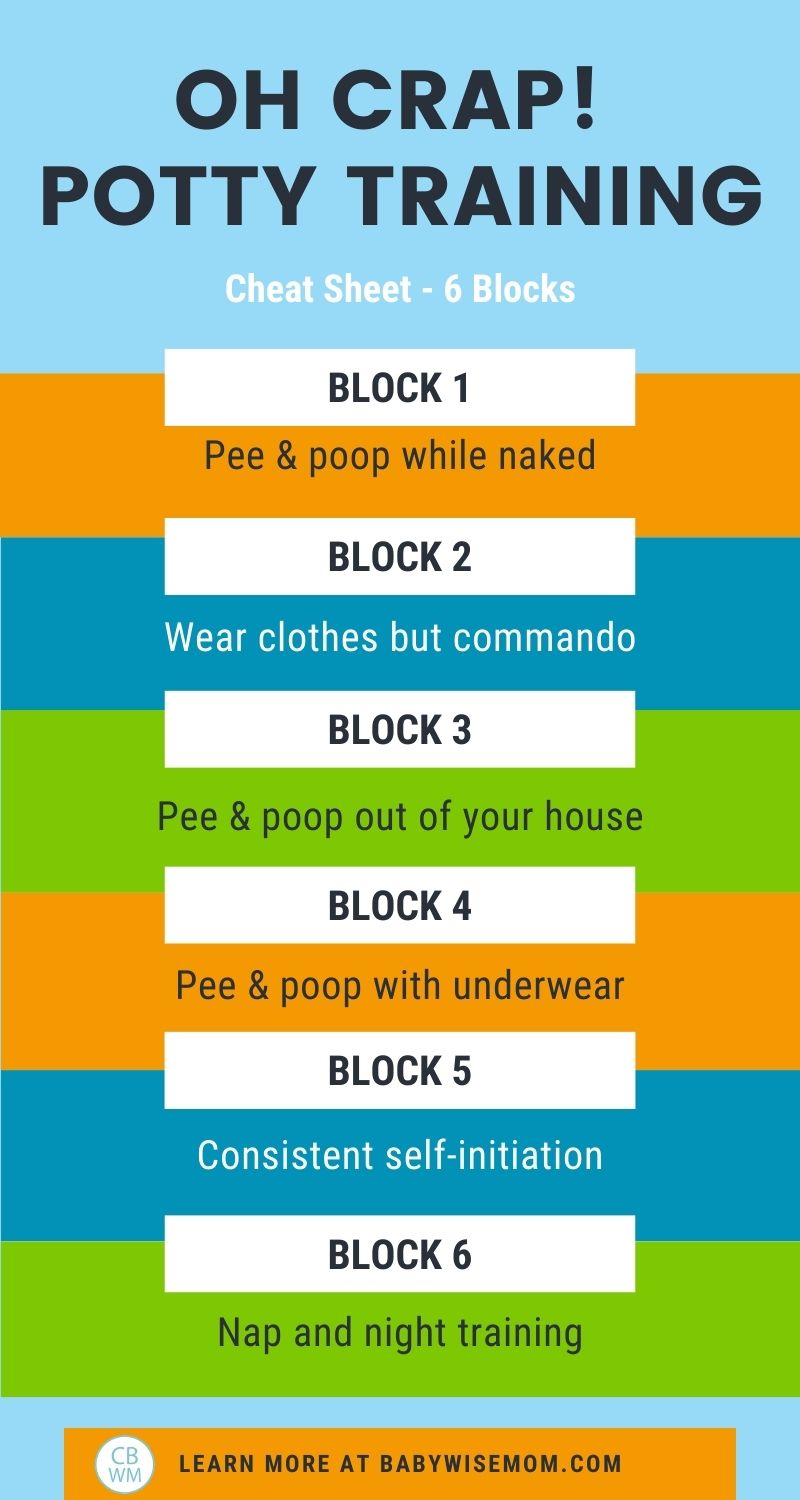
Conclusion
Lots of parents and parenting experts love this potty training method. Potty training is a life skill that all kids will get after a period of time, but it is so nice to have some direction as you spend a couple of weeks daytime potty training. This potty training book is very helpful! You got this mama!
Related Posts
- 7 Best Potty Training Methods
- Best Potty Training Tips from Real Moms
- Potty Training Tips
- 5 Things to Do Before You Start Potty Training
- Surviving Potty Training
- Potty Training at Night: How to Have Success!
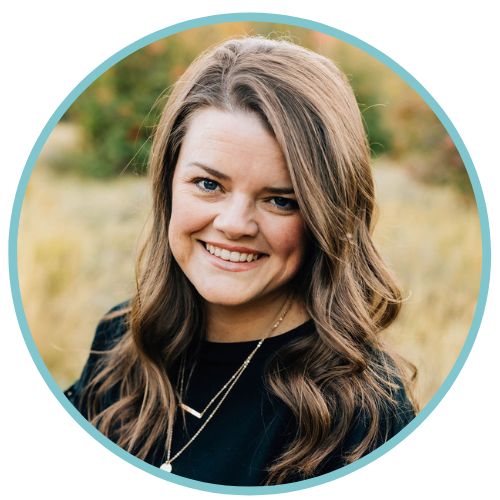
Follow me on YouTube for more parenting content in video form!
This post originally appeared on this blog July 2019
